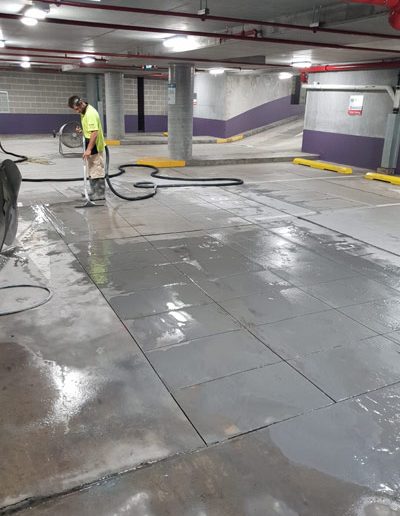When You Know the Proper Concrete Slurry Clean Up – These 5 Ordeals Can Be Avoided
Call Now For an Obligation-FREE Quote
Concrete slurry clean up is generated during polishing, cutting, and grinding operations can be difficult to understand. When working with concrete, the majority of contractors must deal with the unpleasant reality of dealing with slurry waste. The unfortunate reality is that due to the dangerous nature of the concrete slurry, it is not permitted to be thrown directly into drains.
In any type of big-scale construction project, when forms are used to generate large slabs and areas of pure concrete, cement slurry is commonly utilized. It is used all over the world. Cement slurry is a mixture of sand, cement, water, and occasionally lime that can be used for residential and commercial building projects to lay foundations, pour slabs and driveways and perform a variety of other tasks.
Working with concrete slurry has become unavoidable as a result of the Environmental Protection Agency’s (EPA) laws and the Occupational Safety and Health Administration’s (OSHA) new silica dust suggestions. As a result, what is the most appropriate technique for slurry disposal?
The drying of slurry in bins or pits is a routine technique for most contractors, although it takes an inordinate amount of time. Concrete slurry clean up is done by contractors on the job site more quickly and efficiently if they use slurry solidifiers and separators, which are available on the market.
Uncovering Concrete Slurry Clean Up: Is Concrete Slurry Considered a Hazardous Waste?
In the building and construction sector, concrete slurry clean up is an inescapable necessity at times. But before we proceed with concrete slurry removal, what exactly is meant by the term “concrete slurry”?
After grinding, cutting, or coring concrete, the resulting slurry is a combination of water and the solids that make up the concrete. Due to the potentially hazardous nature of concrete slurry waste, it is illegal to dispose of it by simply pouring it down the drain. Therefore, what is the correct concrete slurry removal?
It is possible that the slurry at your work site constitutes hazardous waste, depending on the characteristics of the location and the equipment used for the washout. When cleaning pump truck hoppers and ready-mix trucks, the slurry combination that is produced may be caustic, corrosive, and may even include dangerous metals. Some slurries, when brought into direct contact with the skin, can cause burns and ulcers, thus concrete slurry clean up is highly significant.
Damaging Vegetation: Why Concrete Slurry Clean Up Is Necessary?
As a result of hosing down tools or barrows being emptied in garden beds or onto lawns after washout, concrete slurry frequently makes its way to the surrounding vegetation on the construction site. This is a common occurrence if the concrete slurry is ignored. Furthermore, concrete slurry poses a significant threat to the local flora and fauna causing its deterioration.
The soil’s chemical make-up can be altered and the growth of plants can be stunted if the slurry is allowed to come into contact with it. In addition to this, the slurry can seep into the groundwater, which will only make the problem worse. The plant life in the surrounding area can be negatively impacted if the concrete slurry is allowed to clog stormwater drains and contribute to floods during periods of severe rainfall. By following the proper rules and guidelines, this can be avoided through concrete slurry clean up.
Why Is It Necessary to Have Concrete Slurry Clean Up?
Before we move on to learning how to get rid of slurry, we need to first examine why we should. Concrete slurry clean up would appear ordinary and pointless if one does not have a knowledge of the reasons why it is necessary. When it comes to the correct way to dispose of slurry, the laws and guidelines that govern each state are varied. On the other hand, the disastrous repercussions of contractors exposing concrete slurry to the elements while simultaneously ignoring it are common. First, if the concrete slurry is allowed to run down the pipes, it will speed up the process of the pipes eroding and will either stop the flow of water or cause it to flood.
Second, because the ocean and the storm drain are closely connected, the concrete slurry will have a negative impact on the ocean if it ends up in the storm drain. The slurry used in the production of concrete can have high pH levels and be extremely alkaline. Therefore, if it were to come into contact with the sensitive biosphere of the ocean, it has the potential to inflict severe damage to the aquatic life there. Even if there was no storm drain in the area and the concrete slurry was only left to dry, the wind would blow the particles of the slurry all over the meadows, lakes, and streams as well as the ocean. It is even possible for it to mix into the air that we breathe. With these detrimental impacts of concrete slurry, there is no doubt that concrete slurry clean up should be mandatory.
Concrete Slurry Clean Up: Identifying the Problems and Finding the Solutions
A contractor who is aware and well equipped to deal with concrete slurry will not have a difficult time. This is because there are now a variety of options for dealing with slurry that was not available only a short time ago. You can do some really creative things with these methods, such as swiftly separating water from solids, allowing you to reuse the extracted water in the slurry to continue the grinding process, as well as methods to solidify the slurry in a short period of time.
Concrete Slurry Clean Up: Solution #1 Using Deflocculant
This method is highly beneficial for polishing, grinding, cutting, and drilling concrete. Concrete slurry is made up of many components. Previously, these grindings were difficult to distinguish. But not now. This allows you to quickly separate concrete grindings from the water they are in. This allows the contractor to quickly recycle the water back to the surface, lowering overall water usage.
Using a Deflocculant immediately removes the particles’ negative charge. These hanging concrete partials are like a million tiny magnets that instantly stick together. As a result, they form “flocks” (huge bits of material) and swiftly sink to the bottom, leaving pure water on top. Fun to watch. Despite its coolness, this method does not completely dry the concrete paste. Another step is required, and we’ll discuss it next.
Concrete Slurry Clean Up: Solution #2 Solidifying Agents
These are just powders that you sprinkle on your slurry and move around with your squeegee, and they quickly harden to the point where it is no longer dangerous waste.
Why don’t we talk about this? EPA rules say that if it isn’t wet enough, it isn’t waste. A slurry that isn’t wet enough to pass through a paint filter is what you need to solve this question. Because it has a lot of water in it, this consistency is no longer considered hazardous waste.
Concrete Slurry Clean Up: Solution #3 Settling and Evaporation Pits
Contractors used to dry the slurry out in drums, bens, or lined pits. This is very “old school,” but it’s what they did. This was how most people did things not that long ago. If you live in an area with a lot of rain, it can take months for the slurry to dry out so that it doesn’t have to be thrown away as hazardous waste because of how much water there is in it. Because there are so many other options now, it soon becomes clear that this “old school” method isn’t going to work in most cases.
Concrete Slurry Clean Up: Solution #4 Filter Press Systems
These are systems that push the slurry through a series of filters at a speed of about 20 gallons per minute, which isn’t bad at all. And out the other end comes water that is clean enough to be reused in the grinding process, which reduces the amount of water used on the project. Then, at regular intervals, you pop the filters out and let the concrete solids out. These solids have the consistency of hard-packed clay and are easily solid enough to not be a hazardous waste because of their moisture content.
Concrete Slurry Clean Up: Solution #5 Water Recycling & Slurry Containment Vacuum Systems
This is a special type of wet vacuum that is designed to pick up the slurry and filter the concrete grindings out. Clean water is then returned to the grinder or core drill bit so that it can be used again for cutting, grinding, or drilling. These have both good and bad things about them. You might not want to use this machine for grinding or polishing. It is great for concrete core drilling because it’s small and there is very little water used so there is no slurry in the work area.
In conclusion, there are several different methods available for concrete slurry clean up, the majority of them involve utilising a vacuum system, after which the collected material is placed in a storage container.
If the substance is not dangerous in any manner, including its pH level, then it can be disposed of directly into the ground so long as there is no possibility that the slurry particulate will reach any kind of stream. It is possible to process the slurry by separating the water from the particle matter and doing so if there is a problem with the waterways. In addition, if the slurry is dangerous only due to the fact that it has a high pH, the slurry can be treated with an acid-based solution in order to bring it down to levels that are acceptable.
Why Do Professionals Rely on Wet Polishing?
It’s possible that you’ll find yourself asking, “Why even bother wet polishing a floor?” Wouldn’t the results be the same if you used dry polishing instead?
First and foremost, wet polishing is the most traditional method of polishing, and the use of dry polishing as a method that can produce satisfactory results was only discovered by chance. There are a lot of significant developments that take place whenever water is introduced into the process.
The most important aspect of mechanical wet polishing is the utilization of water as a lubricant. This helps to reduce friction while also allowing the diamond tools to be cooled by the water. It is possible that this will assist in the upkeep of your equipment while simultaneously cleaning the abrasives. In addition, wet polishing reduces the risk of overheating the floor resin and causing it to melt, which is another advantage of using this method.
Worry No More!
Our well-trained and highly skilled team can execute concrete slurry clean up efficiently. We are capable of handling any concrete job no matter how large or small. Give us a call at 0411 835 900 and we’ll be happy to assess your requirements right away!
Get a quote for our concrete slurry solutions by filling out the form below:
Get in touch
76 Railway St Yennora, NSW, 2161
0411 835 900
accounts@advancecutting.com.au
Follow Us


